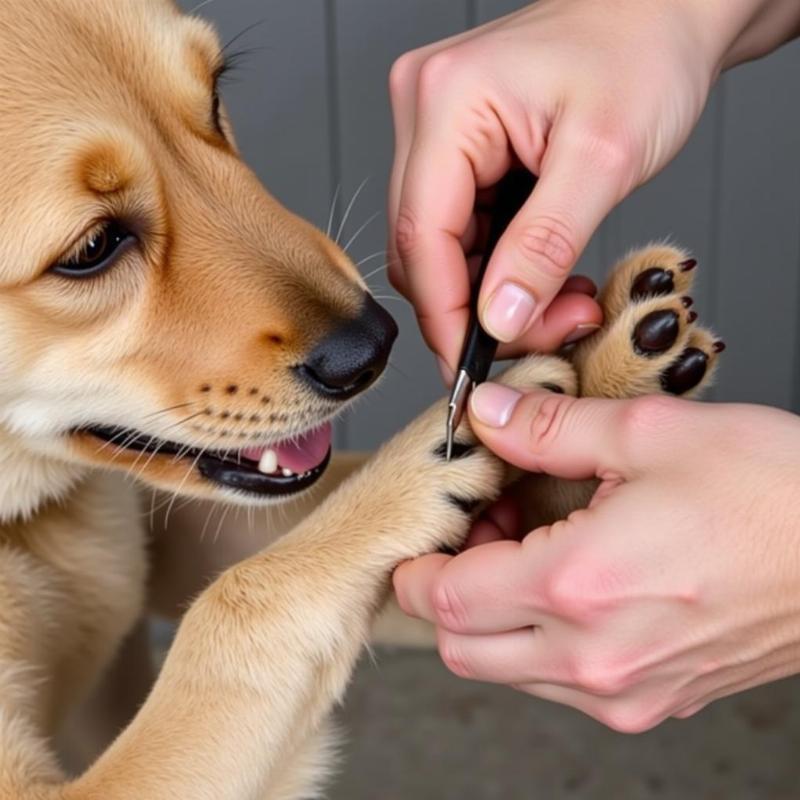Double dew claws, those extra toes high up on a dog’s leg, often spark curiosity and questions. What are they? Why do some dogs have them, and what do owners need to know about their care? This comprehensive guide delves into the fascinating topic of double dew claws, addressing everything from breed specifics to proper maintenance. We’ll explore the genetic basis, potential health concerns, and best practices for keeping these unique appendages healthy and comfortable for your canine companion.
Decoding the Double Dew Claw: Genetics and Breed Predisposition
Double dew claws are essentially extra toes, resembling small thumbs, located higher up on a dog’s leg than the standard dewclaw. While single dew claws are relatively common, double dew claws are more specific to certain breeds, particularly those historically used for herding or working in mountainous terrain. Breeds like the Great Pyrenees, Briard, and Beauceron are known for their double dew claws, which are considered a breed standard by the American Kennel Club. These extra digits provided added traction and stability, allowing these dogs to navigate challenging landscapes. The presence of double dew claws is determined by a specific gene. While most dogs possess the gene for single dew claws, the expression of double dew claws requires an additional genetic factor. This explains why some breeds consistently exhibit double dew claws while others don’t.
Double Dew Claws: Potential Health Concerns and Preventative Care
While double dew claws can be beneficial for certain breeds in specific environments, they can also present potential health risks if not properly cared for. Because they don’t typically touch the ground, double dew claws are prone to overgrowth, which can lead to tearing, infection, and even ingrown nails. Regular trimming is essential to prevent these issues. Owners should consult with a veterinarian or professional groomer on the proper technique for trimming double dew claws, as improper trimming can cause pain and bleeding.
Is Double Dew Claw Removal Necessary?
The question of whether to remove double dew claws is a common one among dog owners. While removal is sometimes recommended to prevent potential injuries, especially for dogs who are very active, it’s a decision that should be made in consultation with a veterinarian. what dogs have double dewclaws Factors to consider include the dog’s breed, lifestyle, and individual risk factors. For some working breeds, retaining the double dew claws can be advantageous, while for other dogs, removal might be the best option to minimize potential health complications.
Living with a Double Dew Clawed Dog: Tips for a Happy, Healthy Pup
Owning a dog with double dew claws requires a bit of extra attention to their paw care. Regular inspections are crucial to identify any potential problems early on. Keep the area around the dew claws clean and dry to prevent infection. dogs with double dew claws on hind legs If you notice any signs of swelling, redness, or discharge, consult your veterinarian promptly.
Expert Insights on Double Dew Claw Care
Dr. Emily Carter, a leading veterinary surgeon in New York City, advises, “Double dew claws require consistent care. Regular trimming is key to preventing overgrowth and subsequent complications. Don’t hesitate to seek professional guidance if you’re unsure about how to trim your dog’s dew claws safely and effectively.”
Dr. Michael Davis, a renowned canine specialist in Los Angeles, adds, “While double dew claws can be beneficial for certain breeds, it’s essential to assess the individual dog’s lifestyle and risk factors when deciding on the best course of action regarding their care. Open communication with your veterinarian is paramount.”
Conclusion
Dogs with double dew claws possess a unique anatomical feature that reflects their historical working roles. Understanding the genetics, potential health concerns, and proper care of double dew claws is vital for ensuring the well-being of these remarkable canines. By following the advice outlined in this guide, you can help your double-dew-clawed companion live a happy, healthy, and comfortable life. dog breeds with back dew claws Remember, regular veterinary check-ups and proactive paw care are essential for preventing potential issues and ensuring your furry friend’s paws stay in tip-top shape.
FAQ
- What breeds commonly have double dew claws? Breeds like the Great Pyrenees, Briard, and Beauceron commonly have double dew claws.
- Are double dew claws always on the hind legs? Yes, double dew claws typically appear on the hind legs.
- Can double dew claws be removed? Yes, double dew claws can be surgically removed, ideally when the dog is a puppy.
- How often should I trim my dog’s double dew claws? Trim your dog’s double dew claws as needed, typically every 2-4 weeks, depending on the growth rate.
- What are the signs of an infected dew claw? Swelling, redness, discharge, and limping are signs of a potentially infected dew claw.
- Do double dew claws affect a dog’s gait? Generally, double dew claws do not affect a dog’s gait unless they are overgrown or injured.
- Are there any special considerations for grooming double dew claws? Yes, be careful when grooming around the double dew claws to avoid cutting the skin.
 Trimming a dog's double dew claws
Trimming a dog's double dew claws
Beautdogs.us is your premier online destination for comprehensive and engaging information on dog care, breeds, and products in the USA. We cater to both novice and experienced dog owners, providing expert advice on everything from puppy training to senior dog care. dog breeds with double dew claws Our team of veterinary professionals and dog breed experts is dedicated to helping you navigate the joys and challenges of dog ownership. Learn more about our services and how we can help you provide the best possible care for your canine companion. Contact us today via email at [email protected] or call us at +1 501-555-7529. Beautdogs.us is committed to empowering you with the knowledge and resources you need to build a strong and loving bond with your furry friend.